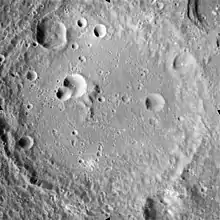 | |
| Coordinates | 17°52′S 108°19′E / 17.87°S 108.32°E |
|---|---|
| Diameter | 173.24 km |
| Depth | Unknown |
| Colongitude | 254° at sunrise |
| Eponym | David Hilbert |


Hilbert is a lunar impact crater that is located on the far side of the Moon, just past the southeast limb. It is named for German mathematician David Hilbert.[1] It lies just beyond the region of the surface that is occasionally brought into view due to libration, and so this feature cannot be observed directly from the Earth.
The crater is attached to the southeast rim of the walled plain Pasteur, a formation nearly half as large again as Hilbert. To the southeast of Hilbert is the smaller crater Alden, while Backlund lies to the west-northwest.
Much of the outer rim of Hilbert remains relatively intact, although it is heavily eroded in places particularly in the south. The interior is relatively flat, but has been deeply gouged by several small craters. There is a short range of central ridges offset to the west of the interior midpoint. Just to the west of the ridges is Hilbert W, a crater with a smaller crater overlying the western rim, giving it a pear-like shape. Hilbert H is a circular, bowl-shaped crater in the east part of the floor. Next to the northern rim is Hilbert Y. There are also many lesser craterlets scattered about the interior.
Satellite craters
By convention these features are identified on lunar maps by placing the letter on the side of the crater midpoint that is closest to Hilbert.
| Hilbert | Latitude | Longitude | Diameter |
|---|---|---|---|
| A | 15.9° S | 108.7° E | 11 km |
| E | 16.5° S | 111.8° E | 49 km |
| G | 19.0° S | 114.0° E | 50 km |
| H | 18.2° S | 109.6° E | 14 km |
| L | 21.2° S | 108.9° E | 32 km |
| S | 18.1° S | 105.8° E | 12 km |
| W | 17.1° S | 107.6° E | 20 km |
| Y | 15.6° S | 107.5° E | 28 km |
References
- ↑ "Hilbert". Gazeteer of Planetary Nomenclature. International Astronomical Union. Retrieved 13 September 2017.
- ↑ The geologic history of the Moon. USGS Professional Paper 1348. By Don E. Wilhelms, John F. McCauley, and Newell J. Trask. U.S. Government Printing Office, Washington: 1987. Table 9-4.
- Andersson, L. E.; Whitaker, E. A. (1982). NASA Catalogue of Lunar Nomenclature. NASA RP-1097.
- Bussey, B.; Spudis, P. (2004). The Clementine Atlas of the Moon. New York: Cambridge University Press. ISBN 978-0-521-81528-4.
- Cocks, Elijah E.; Cocks, Josiah C. (1995). Who's Who on the Moon: A Biographical Dictionary of Lunar Nomenclature. Tudor Publishers. ISBN 978-0-936389-27-1.
- McDowell, Jonathan (July 15, 2007). "Lunar Nomenclature". Jonathan's Space Report. Retrieved 2007-10-24.
- Menzel, D. H.; Minnaert, M.; Levin, B.; Dollfus, A.; Bell, B. (1971). "Report on Lunar Nomenclature by the Working Group of Commission 17 of the IAU". Space Science Reviews. 12 (2): 136–186. Bibcode:1971SSRv...12..136M. doi:10.1007/BF00171763. S2CID 122125855.
- Moore, Patrick (2001). On the Moon. Sterling Publishing Co. ISBN 978-0-304-35469-6.
- Price, Fred W. (1988). The Moon Observer's Handbook. Cambridge University Press. ISBN 978-0-521-33500-3.
- Rükl, Antonín (1990). Atlas of the Moon. Kalmbach Books. ISBN 978-0-913135-17-4.
- Webb, Rev. T. W. (1962). Celestial Objects for Common Telescopes (6th revised ed.). Dover. ISBN 978-0-486-20917-3.
- Whitaker, Ewen A. (1999). Mapping and Naming the Moon. Cambridge University Press. ISBN 978-0-521-62248-6.
- Wlasuk, Peter T. (2000). Observing the Moon. Springer. ISBN 978-1-85233-193-1.